 W
WThe Kingdom of Romania was neutral for the first two years of World War I, entering on the side of the Allied powers from 27 August 1916 until Central Power occupation led to the Treaty of Bucharest in May 1918, before reentering the war on 10 November 1918. It had the most significant oil fields in Europe, and Germany eagerly bought its petroleum, as well as food exports.
 W
WThe Battle of the Argeș was a battle of the Romanian Campaign of World War I. Taking place on 1 December 1916, the battle was fought along the line of the Argeș River in Romania between Austro-German forces of the Central Powers and Romanian forces.
 W
WThe Battle of Herkulesfürdő was a military engagement during the Romanian Campaign of World War I. It was fought between Romanian forces on one side and Central Powers forces on the other side. It resulted in a Romanian victory.
 W
WThe Battle of Kolun was a World War I military engagement fought between Romanian and Central Powers forces. It was part of the wider Battle of Transylvania and resulted in a tactical victory for the Central Powers.
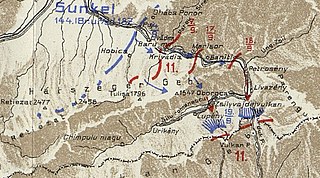 W
WThe Battle of Mezőlivádia was a military engagement fought between Romanian and Central Powers forces during the Romanian Campaign of the First World War. It was part of the Battle of Transylvania. This battle is notable for being the first Central Powers counterattack against the Romanian invasion of Transylvania, as well as the first military engagement during the Battle of Transylvania to involve German forces. The battle resulted in a Romanian victory.
 W
WThe Battle of Mount Csindrel was a World War I military engagement between German and Romanian forces. It was part of the 1916 Battle of Transylvania and resulted in a tactical victory for the Romanians.
 W
WThe Battle of Nagybár was a military engagement between Romanian forces on one side and Central Powers forces on the other side. It was part of the 1916 Battle of Transylvania during the Romanian Campaign of World War I. The battle resulted in a Romanian victory.
 W
WThe Battle of Nagyszeben was a World War I military engagement fought between the forces of the Central Powers on one side and the forces of Romania on the other side. It was the decisive engagement during the Battle of Transylvania, and also the largest, involving four armies out of the five fighting in the region: two Romanian, one German, and one Austro-Hungarian.
 W
WThe Battle of Sellenberk was a World War I military engagement fought between Romanian forces on one side and Central Powers forces on the other side. It was part of the wider Battle of Transylvania and resulted in a Romanian victory.
 W
WThe Battle of Bazargic, also known as the Battle of Dobrich or the Dobrich epopee, took place between 5 and 7 September 1916 between a joint Bulgarian–German–Ottoman force, consisting mainly of the Bulgarian Third Army, and a Romanian–Russian force, including a Division of Serbian Volunteers serving under the Russian 47th Corps.
 W
WThe Battle of Brassó was the last major military engagement during the Battle of Transylvania. It took place between 7 and 9 October 1916, between Central Powers forces on one side and Romanian forces on the other side. As Brassó was the second largest city in Transylvania and the largest Transylvanian settlement taken by the Romanians during their August-September offensive in the region, the retreating Romanian forces decided to make a stand there. However, when its defense proved untenable, the Romanian 2nd Army withdrew from the city, leaving behind only 1,175 prisoners. As the Romanians failed to defend Brassó, so did the Central Powers fail to cut off their escape route, enabling the Romanians to regroup and - under better leadership - thwart the German and Austro-Hungarian attempts to break through the mountains in the region throughout the following month.
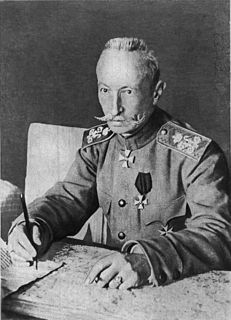 W
WThe Brusilov Offensive, also known as the "June Advance", of June to September 1916 was the Russian Empire's greatest feat of arms during World War I, and among the most lethal offensives in world history. The historian Graydon Tunstall called the Brusilov Offensive the worst crisis of World War I for Austria-Hungary and the Triple Entente's greatest victory, but it came at a tremendous loss of life. The heavy casualties eliminated the offensive power of the Imperial Russian Army and contributed to Russia's collapse the next year.
 W
WThe Battle of Bucharest, also known as the Argeş–Neajlov Defensive Operation in Romania, was the last battle of the Romanian Campaign of 1916 in World War I, in which the Central Powers' combatants, led by General Erich von Falkenhayn, occupied the Romanian capital and forced the Romanian Government, as well as the remnants of the Romanian Army to retreat to Moldavia and re-establish its capital at Iaşi.
 W
WThe Battle of Dragoslavele was a military engagement fought between Romanian forces on one side and Central Powers forces on the other. It was part of the Romanian Campaign of World War I. The battle resulted in a Romanian victory and the effective end of Central Powers advances in the area.
 W
WThe Battle of the Eastern Carpathians consisted in a series of military engagements between Romanian and Austro-Hungarian forces during October 1916, in World War I. The attempt of the Austro-Hungarian 1st Army to break through the Eastern Carpathians was simultaneous with that of the German 9th Army to force the passes of the Southern Carpathians. Both efforts failed.
 W
WThe First Battle of Petrozsény was a military engagement fought between Romanian forces on one side and German forces on the other side. It was part of the 1916 Battle of Transylvania, itself part of the Romanian Campaign of World War I. This was a German attack which drove off the Romanian forces from the Transylvanian coal mining center of Petrozsény. Although a Romanian counterattack a few days later undid most of their gains, the main strategic objective of the Central Powers had been nevertheless achieved.
 W
WThe Flămânda Offensive, which took place during World War I between 29 September and 5 October 1916, was an offensive across the Danube mounted by the Romanian 3rd Army supported by Romanian coastal artillery. Named after the hamlet of Flămânda, the battle represented a consistent effort by the Romanian Army to stop the Central Powers' southern offensive led by August von Mackensen. The battle ended as a tactical victory for the Central Powers.
 W
WThe First Battle of the Jiu Valley was a military engagement during World War I fought between Romanian forces on one side and Central Powers forces on the other. The German offensive, although initially successful, was checked within days and subsequently repulsed by a Romanian counterattack. This was the most conspicuous Romanian victory during the 1916 campaign, given that it was achieved against forces which were superior in artillery and - initially - in numbers as well.
 W
WThe Second Battle of the Jiu Valley was a military engagement between German and Romanian forces during the Romanian Campaign of World War I. It lasted between 7 and 17 November 1916 and resulted in a German victory.
 W
WThe Kerensky Offensive, also commonly known as the July Offensive or Galician Offensive, was the last Russian offensive in World War I. It took place in July 1917. It was decided by Alexander Kerensky, Minister of War in the Russian provisional government, and led by General Aleksei Brusilov. Such a decision was ill-timed, because, following the February Revolution, there were strong popular demands for peace, especially within the Russian Army, whose fighting capabilities were quickly deteriorating.
 W
WThe Battle of Kőhalom was a military engagement during the Battle of Transylvania, at the beginning of the Romanian Campaign of World War I. It consisted in a German offensive that was successfully repulsed by the Romanians, who then carried out a largely unhindered tactical retreat.
 W
WThe Mamornița border clash was an incursion of Russian forces into Romanian territory during the Brusilov Offensive in World War I. As Romania was neutral at the time, the Russian forces left Romanian territory soon afterwards.
 W
WThe Battle of Mărășești was the last major battle between the German Empire and the Kingdom of Romania on the Romanian front during World War I. Romania was mostly occupied by the Central Powers, but the Battle of Mărășești kept the northeastern region of the country free from occupation.
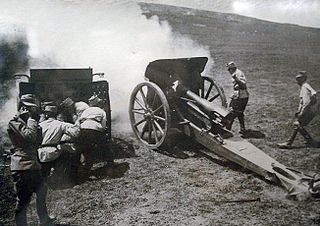 W
WThe Battle of Mărăști was one of the main battles to take place on Romanian soil in World War I. It was fought between July 22 and August 1, 1917, and was an offensive operation of the Romanian and Russian Armies intended to encircle and destroy the German 9th Army. The operation was planned to occur in tandem with the Nămoloasa offensive; however, this operation was abandoned before it began.
 W
WThe Nagyszeben Offensive was a Romanian military operation during the opening stages of the Battle of Transylvania, during the Romanian Campaign of 1916 in World War I. It was fought against Austro-Hungarian forces and resulted in a Romanian victory, the city of Nagyszeben (Sibiu/Hermannstadt) being reached within a week. A further week of minor operations following the one-day Romanian occupation of the city resulted in the stabilization of the Romanian front line in the region for the ensuing fortnight.
 W
WThe Second Battle of Oituz was fought between 10 November and 16 November 1916. The Romanian forces, led by Brigadier-General Eremia Grigorescu, faced off against an Austro-Hungarian and German force led by Friedrich von Gerok. The battle resulted in the failure of the attempt by the Central Powers to force the Carpathian Mountains and enter the Siret valley in order to cut in two the strategic device of the Romanian forces.
 W
WThe Battle of the Olt Valley consisted in a prolonged military engagement during World War I between Romanian forces on one side and Central Powers' forces on the other side. Within just under a month, the Central Powers had managed to conquer the 30 miles (48 km)-long Olt Valley from its Romanian defenders.
 W
WThe Orsova Offensive was a military engagement fought between the armies of Romania and Austria-Hungary at the start of the Romanian Campaign in August–September 1916. It ended in a Romanian victory which led to the Romanian occupation of the west bank of the Cserna (Cerna) River for over two months.
 W
WThe Petrozsény Offensive was the opening action of the south-western front of the 1916 Battle of Transylvania, during World War I. The Transylvanian coal-mining center of Petrozsény (Petroșani) was occupied by the Romanian Army on 29 August, two days after the Kingdom of Romania declared war on Austria-Hungary.
 W
WThe Pitești-Târgoviște Retreat was a fighting-withdrawal operation carried out by the Romanian 1st Army in the face of advancing Central Powers' forces during World War I. The retreat lasted from 29 November to 3 December and culminated in a violent battle at Târgoviște, after which the entire Romanian Army started a general retreat towards Moldavia.
 W
WThe Battle of Predeal Pass was a military engagement during the Romanian Campaign of World War I. It consisted in an attempt by the Central Powers to cross the mountains to the south of Brassó (Brașov). Although the Central Powers captured the town of Predeal itself, the Romanian defenses in the pass prevented any further advances.
 W
WThe Battle of Prunaru was a military engagement between German and Romanian forces during the Romanian Campaign of World War I. It resulted in a tactical German victory, but following the heavy Romanian resistance the Germans halted after taking Prunaru. General Constantin Prezan's maneuver group checked the German forces in the region within two days, exposing the left flank of Field Marshal August von Mackensen's Danube Army.
 W
WAfter a series of quick tactical victories on the numerically overpowered Austro-Hungarian forces in Transylvania, in the autumn of 1916, the Romanian Army suffered a series of devastating defeats, which forced the Romanian military and administration to withdraw to Western Moldavia, allowing the Central Powers to occupy two thirds of the national territory, including the state capital, Bucharest.
 W
WThe 1917 Romanian Campaign consisted in three battles between late July and early September 1917, fought between Germany and Austria-Hungary on one side and Romania and Russia on the other. Romania emerged from this campaign with a slight net territorial gain and won its most important battle during the First World War.
 W
WThe Romanian Debacle consisted in a series of battles between November and December 1916 which led to the Central Powers conquest of Bucharest, the capital of Romania. Russian forces joined the Romanians at the start of December.
 W
WThe Battle of Sălătrucu was a military engagement during the Romanian Campaign of World War I. It took place after the Battle of Transylvania and resulted in a Romanian victory. A mixed Central Powers force – under German leadership but with mostly Austro-Hungarian troops – conducted a failed offensive into Romanian territory, south of the Turnu Roșu Pass.
 W
WThe Second Battle of Petrozsény was a World War I military engagement between Romanian forces on one side and Central Powers forces on the other side. It was part of the wider Battle of Transylvania and resulted in a Romanian victory.
 W
WThe Battle of Slatina was a military engagement between Romanian and German forces during World War I. It resulted in a strategic victory for the Romanians.
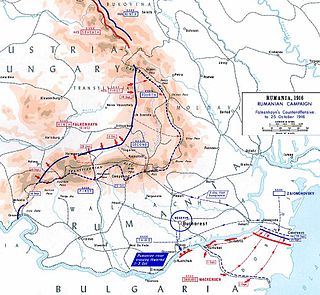 W
WThe Battle of the Southern Carpathians was a major operation during the Romanian Campaign of World War I. The brainchild of German General Erich von Falkenhayn, the operation consisted in an attempt by the Central Powers to assault all of the passes in the Southern Carpathians at the same time, and exploit a success wherever it might have come. However, this did not happen, as Romanian defenses could not be defeated in any of the five areas that Falkenhayn's spread-out army tried to force.
 W
WThe Third Battle of Petrozsény was a World War I military engagement between Romanian forces on one side and Central Powers forces on the other side. It was part of the wider Battle of Transylvania and the last engagement in the area around Petrozsény. The battle resulted in a Central Powers victory.
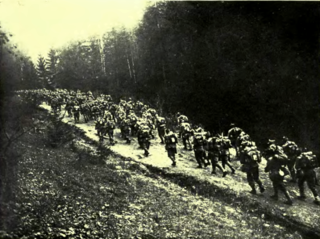 W
WThe Battle of Transylvania was the first major operation of the Romanian forces Campaign during World War I, beginning on 27 August 1916. It started as an attempt by the Romanian Army to seize Transylvania, and potentially knock Austria-Hungary out of the war. Although initially successful, the offensive was brought to a halt after Bulgaria's attack on Dobruja. Coupled with a successful German and Austro-Hungarian counterattack which started in mid-September, the Romanian Army was eventually forced to retreat back to the Carpathians by mid-October. The Romanian armies however managed to escape the Central Powers' attempts to completely destroy them. The Battle of Transylvania also caused the replacement of the Chief of Staff of the German Army and the shifting of German attention to the region, causing German offensive operations at Verdun to cease.
 W
WOn 27 August 1916, Romania entered World War I on the side of the Allies, three of its armies invading Transylvania. The 1st and 2nd Armies invaded the southern part, while the Romanian North Army invaded the northeastern part. Unlike the 1st and 2nd Armies - which had to contend with a German-led counter-offensive - the North Army faced primarily Austro-Hungarian forces, and as such its campaign hardly had any major battles. After conquering three Hungarian urban districts, the undefeated North Army was ordered to withdraw due to events outside its control, after inflicting heavier losses than those it had incurred.
 W
WThe Battle of Turtucaia, also known as Tutrakan Epopee in Bulgaria, was the opening battle of the first Central Powers offensive during the Romanian Campaign of World War I. The battle lasted for five days and ended with the capture of the fortress of Turtucaia and the surrender of its Romanian defenders.
 W
WThe Veresmart Offensive was a World War I military engagement between Romanian forces on one side and Central Powers forces on the other side. It was part of the larger Battle of Transylvania. Although the Romanians failed to reach their planned objective, the strategic situation of the Central Powers was significantly worsened by the Romanian attack. Nevertheless, the Romanian forces did not exploit their strategic success further.